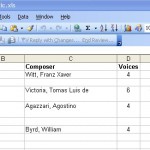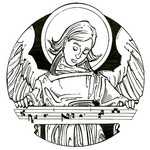For scholas just starting out, or parishes where there is no choir but only a cantor, the CMAA offers two resources. 1) The Rossini propers, and 2) Propers of the Church Year set to their assigned tones. They are both linked permanently in the sidebar.
Polyphonic Propers
- Friday, 02 November 2007 10:11
As we know from the General Instruction of the Roman Missal (2011, para. 48), the United States Conference of Catholic Bishops follows the Church in stating that the Church’s first preference for musical settings of texts proper to the day is “the antiphon from the Roman Missal or the Psalm from the Roman Gradual as set to music there or in another musical setting.” The music of the Roman Gradual is of course Gregorian chant.
What “other musical settings” is the Church referring to, and does it have any preference? If we read the Second Vatican Council’s constitution on the sacred liturgy, Sacrosanctum Concilium, we find (par. 116) that the Church says “especially polyphony” when it considers alternatives to Gregorian chant. How should we understand this phrase and its explicit preference? The most Catholic way would be to interpret it in the extraordinarily inclusive light of Catholic tradition. Accordingly, polyphony means “the Roman Catholic tradition of sacred polyphonic vocal music.”
As our beloved Pope Benedict’s recent remarks on music make quite clear, the tradition of Roman Catholic sacred music is not something immobilized and encased in amber. There is indeed room for organic musical development, which is obviously what the Pope means when he speaks of “worthy novelties” in sacred music. “Organic development” means growth that displays clear filiation, procession, elaboration — not high modernist avant-gardism, not self-conscious rebellion, not gadding about like a witless consumer after the latest cultural fashions. In order to avoid these overly-selfish forms of musical pursuit, it is necessary to immerse oneself in the music of musical predecessors who saw their own work as musical extensions and developments of sacred chant.
This can be done. And if one wishes to set — and sing! — the Church’s first preference for sung Propers, here is a spreadsheet of the Propers with links to polyphonic settings of them (click on the image):


